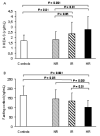Increased clearance of cortisol by 5beta-reductase in a subgroup of women with adrenal hyperandrogenism in polycystic ovary syndrome
- PMID: 19542736
- PMCID: PMC4425940
- DOI: 10.1007/BF03346454
Increased clearance of cortisol by 5beta-reductase in a subgroup of women with adrenal hyperandrogenism in polycystic ovary syndrome
Abstract
Objective: Increased peripheral metabolism of cortisol may explain compensatory ACTH-dependent adrenal steroidogenesis and hence hyperandrogenism in polycystic ovary syndrome (PCOS). Previous studies have described an increased 5alpha-reduction of cortisol or impaired regeneration of cortisol by 11beta-HSD1 in PCOS. However, these observations may be confounded by obesity. Moreover, the relationship between alterations in cortisol metabolism and the extent of adrenal androgen hyper-secretion in response to ACTH has not been established. This study aimed to examine the association between cortisol metabolism and ACTH-dependent adrenal hyperandrogenism in PCOS, independently of obesity.
Design: We compared 90 PCOS women (age 18-45 yr) stratified by adrenal androgen responses to ACTH1-24 and 45 controls matched for age and body weight.
Methods: PCOS women were stratified as normal responders (NR), intermediate responders (IR), and high responders (HR) to 250 microg ACTH1-24: NR (no.=27) had androstenedione and DHEA responses within 2 SD of the mean in controls; IR (no.=43) had DHEA responses >2 SD above controls; HR (no.=20) had both androstenedione and DHEA responses >2 SD above controls.
Results: All groups were similar for age, body weight, and body fat distribution. Basal testosterone, androstenedione, and 5alpha-dihydrotestosterone plasma levels were similarly elevated among the 3 groups of PCOS compared with controls, whereas basal DHEA-S was higher in HR (2.8+/-1.2 microg/ml) and IR (2.4+/-1.1 microg/ml) than in NR (1.8+/-0.8 microg/ml) and controls (1.7+/-0.6 microg/ml). The HR group had the lowest basal plasma cortisol levels (101+/-36 ng/ml vs IR 135+/-42 ng/ml, NR 144+/-48 ng/ml, and controls 165+/-48 ng/ml; all p<0.01), but the greatest cortisol response to ACTH1-24 (Delta(60-0)cortisol 173+/-60 ng/ml vs IR 136+/-51 ng/ml, NR 114+/-50 ng/ml, and controls 127+/-50 ng/ml; all p<0.01), and the highest urinary excretion of total and 5beta-reduced cortisol metabolites (eg 5beta-tetrahydrocortisol/ cortisol ratio 25.2+/-15.3 vs IR 18.8+/-10.7, NR 19.7+/-11.4, and controls 17.2+/-13.7; all p<0.05). There were no differences in urinary excretion of 5alpha-reduced cortisol metabolites or in 5alpha-dihydrotestosterone/testosterone ratio between groups.
Conclusions: Adrenal androgen excess in PCOS is associated with increased inactivation of cortisol by 5beta-reductase that may lower cortisol blood levels and stimulate ACTH-dependent steroidogenesis.
Figures




Similar articles
-
Altered cortisol metabolism in polycystic ovary syndrome: insulin enhances 5alpha-reduction but not the elevated adrenal steroid production rates.J Clin Endocrinol Metab. 2003 Dec;88(12):5907-13. doi: 10.1210/jc.2003-030240. J Clin Endocrinol Metab. 2003. PMID: 14671189
-
Adrenal hyperandrogenism is induced by fetal androgen excess in a rhesus monkey model of polycystic ovary syndrome.J Clin Endocrinol Metab. 2005 Dec;90(12):6630-7. doi: 10.1210/jc.2005-0691. Epub 2005 Sep 20. J Clin Endocrinol Metab. 2005. PMID: 16174719 Free PMC article.
-
Hyperandrogenism in women with polycystic ovary syndrome persists after menopause.J Clin Endocrinol Metab. 2011 Mar;96(3):623-31. doi: 10.1210/jc.2010-0130. Epub 2010 Dec 22. J Clin Endocrinol Metab. 2011. PMID: 21177795
-
DHEA, DHEAS and PCOS.J Steroid Biochem Mol Biol. 2015 Jan;145:213-25. doi: 10.1016/j.jsbmb.2014.06.003. Epub 2014 Jul 5. J Steroid Biochem Mol Biol. 2015. PMID: 25008465 Review.
-
Androgens in Cushing's Syndrome.Front Horm Res. 2019;53:77-91. doi: 10.1159/000494904. Epub 2019 Sep 9. Front Horm Res. 2019. PMID: 31499501 Review.
Cited by
-
5α-reductase activity in women with polycystic ovary syndrome: a systematic review and meta-analysis.Reprod Biol Endocrinol. 2017 Mar 27;15(1):21. doi: 10.1186/s12958-017-0242-9. Reprod Biol Endocrinol. 2017. PMID: 28347315 Free PMC article.
-
Harmful effects of functional hypercortisolism: a working hypothesis.Endocrine. 2014 Aug;46(3):370-86. doi: 10.1007/s12020-013-0112-y. Epub 2013 Nov 27. Endocrine. 2014. PMID: 24282037 Review.
-
Improved Urinary Cortisol Metabolome in Addison Disease: A Prospective Trial of Dual-Release Hydrocortisone.J Clin Endocrinol Metab. 2021 Mar 8;106(3):814-825. doi: 10.1210/clinem/dgaa862. J Clin Endocrinol Metab. 2021. PMID: 33236103 Free PMC article. Clinical Trial.
-
Pathophysiology and Nutritional Approaches in Polycystic Ovary Syndrome (PCOS): A Comprehensive Review.Curr Nutr Rep. 2023 Sep;12(3):527-544. doi: 10.1007/s13668-023-00479-8. Epub 2023 May 22. Curr Nutr Rep. 2023. PMID: 37213054 Free PMC article. Review.
-
The Importance of Sleep Hygiene in Polycystic Ovary Syndrome from the View of Iranian Traditional Medicine and Modern Medicine.Int J Prev Med. 2018 Oct 12;9:87. doi: 10.4103/ijpvm.IJPVM_352_16. eCollection 2018. Int J Prev Med. 2018. PMID: 30450170 Free PMC article. Review.
References
-
- Carmina E, Koyama T, Chang L, Stanczyk FZ, Lobo RA. Does ethnicity influence the prevalence of adrenal hyperandrogenism and insulin resistance in polycystic ovary syndrome? Am J Obstet Gynecol. 1992;167:1807–1812. - PubMed
-
- Wild RA, Umstot ED, Andersen RN, Ranney GB, Givens JR. Androgen parameters and their correlation with body weight in one hundred thirty-eight women thought to have hyperandrogenism. Am J Obstet Gynecol. 1983;146:602–605. - PubMed
-
- Hoffman DI, Klove K, Lobo RA. The prevalence and significance of elevated dehydroepiandrosterone sulfate levels in anovulatory women. Fertil Steril. 1984;42:76–81. - PubMed
-
- Azziz R, Black V, Hines GA, Fox LM, Boots LR. Adrenal androgen excess in the polycystic ovary syndrome: sensitivity and responsivity of the hypothalamic-pituitary-adrenal axis. J Clin Endocrinol Metab. 1998;83:2317–2323. - PubMed
-
- Walker BR. Activation of the hypothalamic-pituitary-adrenal axis: cause or consequence? GH & IGF Res. 2001;11(Suppl A):S91–95. - PubMed
Publication types
MeSH terms
Substances
Grants and funding
LinkOut - more resources
Full Text Sources
Medical

